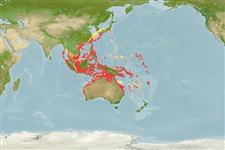Common names from other countries
Environment: milieu / climate zone / Tiefenbereich / distribution range
Ökologie
seewasser benthopelagisch; tiefenbereich 1 - 78 m (Ref. 11897). Tropical; 38°N - 31°S, 90°E - 179°E
Eastern Indian Ocean and Western Pacific: Andaman Sea to Fiji, north to Japan, south to Australia. Replaced by Ablabys binotatus in the western Indian Ocean (Ref. 9710).
Size / Gewicht / Alter
Geschlechtsreife: Lm ? range ? - ? cm
Max length : 15.0 cm TL Männchen/unbestimmt; (Ref. 48635)
Rückenflossenstacheln (insgesamt) : 17 - 18; Rückenflossenweichstrahlen (insgesamt) : 6 - 7; Afterflossenstacheln: 3; Afterflossenweichstrahlen: 4 - 5.
Body shape (shape guide): short and / or deep.
Inhabits shallow, subtidal areas with sand rubble and weed (Ref. 9710). A strongly compressed fish that can be seen rocking back and forth on the bottom in response to surge. Easily caught with small hand nets. Nocturnal (Ref. 48635). Solitary or in pairs (Ref 90102).
Life cycle and mating behavior
Geschlechtsreife | Fortpflanzung | Ablaichen | Eier | Fecundity | Larven
Randall, J.E., G.R. Allen and R.C. Steene, 1990. Fishes of the Great Barrier Reef and Coral Sea. University of Hawaii Press, Honolulu, Hawaii. 506 p. (Ref. 2334)
IUCN Rote Liste Status (Ref. 130435: Version 2025-1)
Bedrohung für Menschen
Venomous
Nutzung durch Menschen
Fischereien: kommerziell; Aquarium: Kommerziell
Tools
Zusatzinformationen
Download XML
Internet Quellen
Estimates based on models
Preferred temperature (Ref.
123201): 23.5 - 29, mean 28.1 °C (based on 1122 cells).
Phylogenetic diversity index (Ref.
82804): PD
50 = 0.5312 [Uniqueness, from 0.5 = low to 2.0 = high].
Bayesian length-weight: a=0.01905 (0.00776 - 0.04678), b=3.03 (2.82 - 3.24), in cm total length, based on LWR estimates for this (Sub)family-body shape (Ref.
93245).
Trophic level (Ref.
69278): 3.2 ±0.3 se; based on size and trophs of closest relatives
Widerstandsfähigkeit (Ref.
120179): mittel, Verdopplung der Population dauert 1,4 - 4,4 Jahre. (Preliminary K or Fecundity.).
Fishing Vulnerability (Ref.
59153): Low vulnerability (10 of 100).
🛈
Nutrients (Ref.
124155): Calcium = 158 [70, 338] mg/100g; Iron = 0.965 [0.445, 2.055] mg/100g; Protein = 15.9 [14.3, 17.5] %; Omega3 = 0.275 [0.103, 0.851] g/100g; Selenium = 51.1 [22.6, 131.7] μg/100g; VitaminA = 46 [12, 187] μg/100g; Zinc = 1.57 [0.99, 2.44] mg/100g (wet weight);
